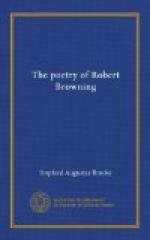He could not do it; the time was not ripe enough. But he began it. And the spirit of its coming breaks out in all he did.
We take a leap of more than half a century when we pass from Fra Lippo Lippi to Andrea del Sarto. That advance in art to which Lippo Lippi looked forward with a kind of rage at his own powerlessness had been made. In its making, the art of the Renaissance had painted men and women, both body and soul, in every kind of life, both of war and peace; and better than they had ever been painted before. Having fulfilled that, the painters asked, “What more? What new thing shall we do? What new aim shall we pursue?” And there arose among them a desire to paint all that was paintable, and especially the human body, with scientific perfection. “In our desire to paint the whole of life, we have produced so much that we were forced to paint carelessly or inaccurately. In our desire to be original, we have neglected technique. In our desire to paint the passions on the face and in the movements of men, we have lost the calm and harmony of the ancient classic work, which made its ethical impression of the perfect balance of the divine nature by the ideal arrangement, in accord with a finished science, of the various members of the body to form a finished whole. Let the face no longer then try to represent the individual soul. One type of face for each class of art-representation is enough. Let our effort be to represent beauty by the perfect drawing of the body in repose and in action, and by chosen attitudes and types. Let our composition follow certain guiding lines and rules, in accordance with whose harmonies all pictures shall be made. We will follow the Greek; compose as he did, and by his principles; and for that purpose make a scientific study of the body of man; observing in all painting, sculpture, and architecture the general forms and proportions that ancient art, after many experiments, selected as the best. And, to match that, we must have perfect drawing in all we do.”
This great change, which, as art’s adulterous connection with science deepened, led to such unhappy results, Browning represents, when its aim had been reached, in his poem, Andrea del Sarto; and he tells us—through Andrea’s talk with his wife Lucretia—what he thought of it; and what Andrea himself, whose broken life may have opened his eyes to the truth of things, may himself have thought of it. On that element in the poem I have already dwelt, and shall only touch on the scenery and tragedy, of the piece:
We sit with Andrea, looking out to Fiesole.
sober,
pleasant Fiesole.
There’s the bell clinking
from the chapel top;
That length of convent-wall
across the way
Holds the trees safer, huddled
more inside;
The last monk leaves the garden;
days decrease,
And autumn grows, autumn in
everything.
As the poem goes on, the night falls, falls with the deepening of the painter’s depression; the owls cry from the hill, Florence wears the grey hue of the heart of Andrea; and Browning weaves the autumn and the night into the tragedy of the painter’s life.




